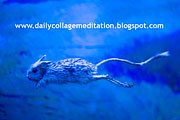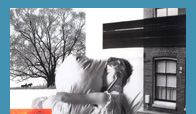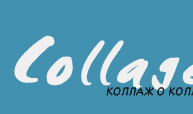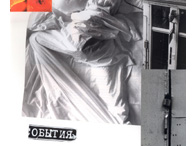Новая серия коллажей Ах как хочется цвета!
9.01.2011
Новая серия коллажей И все они - Любовь
28.12.2010
Новая серия коллажей Звонкие звезды

 |  |  |

Новости
20.02.2011 Новая серия коллажей Ах как хочется цвета! 9.01.2011 Новая серия коллажей И все они - Любовь 28.12.2010 Новая серия коллажей Звонкие звезды 
|
В Центральном музее связи имени А.С.Попова подготовлен курс лекций на тему: «Всемирный почтовый дизайн», рассказывающий об основных художественных стилях, таких как неоклассицизм, эклектика, модерн, Ар деко, функционализм-конструктивизм и других, повлиявших на оформление почтовых документов. Курс рассчитан на широкий круг посетителей. Лекции читает искусствовед, переводчик, член Международной ассоциации искусствоведов - Дьяченко Андрей Петрович.
далее Персоны Весь список Искусство Весь список Открытки О сайте КЛЕКСОГРАФИЯ искусство нанесения клякс и неровных расползающихся пятен на бумагу и картон в эстетических целях. Широко используется в искусстве коллажа
|
Коллажи Ханны Хёх
Hoch, Hannah (1889-1978) German bisexual artist Hannah Hoch is best known for her photomontages. She assembled images--often taken from popular magazines--into commentaries on gender and politics, frequently critiquing German bourgeois culture. She also made drawings and paintings (oil, watercolor, and gouache), participated in fabric and fashion design, and created dolls. Hannah Hoch was born Anna Therese Johanne Hoch into a middle-class family in Gotha, a small town in Thuringia, in 1889. Between 1912 and 1920, she studied art at the Kunstgewerbeschule Charlottenburg (Charlottenburg School of Applied Arts) and the Unterrichtsanstalt des koniglichen Kunstgewerbemuseums (School of the Royal Museum of Applied Arts) in Berlin. The position of women in European society changed rapidly during this period and the "New Woman" was a popular theme to which Hoch responded in her art. Between 1915 and 1922, Hoch was involved with Austrian-born artist Raoul Hausmann (1886-1971), a married man. Although Hoch wanted Hausmann to leave his wife and daughter and live monogamously with her, he refused to do so. As members of the Berlin Dada, Hoch and Hausmann developed the art of photomontage (photographic images collaged onto paper) as a tool of artistic commentary. Dada--a response to the devastation of World War I--was a tumultuous, anarchistic, nihilistic movement that flourished between 1916 and 1922 in Zurich, New York, Cologne, Hanover, Berlin, and Paris. Hoch's best known work is the 1919-1920 photomontage titled "Cut with the Kitchen Knife Dada through the Last Weimar Beer-Belly Cultural Epoch of Germany," which combines images of men (military, government, Communists, radicals), images of women (dancers, athletes, actresses, artists), pictures of man-made objects (especially gears), and words ("DADA" is repeated three times).
In 1926, almost four years after her 1922 breakup with Hausmann, Hoch entered into a lesbian relationship with the Dutch writer and linguist Til Brugman (ca 1888-1958). They remained together for nine years, living in The Hague from 1926 to 1929, then in Berlin. The two women collaborated on some projects, including a book, Scheingehacktes (1935), for which Hoch provided the images and Brugman the text. Later, Hoch would remember her time with Brugman as one of the happiest in her life, but also complain of Brugman's possessiveness. During her time with Brugman, she produced a number of photomontages depicting same-sex couples. During the 1930s, Hoch embraced Surrealism, a movement to which her style of juxtaposing disparate human and animal parts was especially well-suited. In 1935, while still involved with Til Brugman, Hoch began a romance with businessman and amateur musician Heinz Kurt Matthies, twenty-one years younger than she. They married in 1939, separated in 1942, and divorced in 1944. For the remaining thirty-four years of her life, the artist chose solitude over romance. Although Hoch's art was of a kind particularly denounced by the Nazis as degenerate, the artist managed to survive the Nazi period without suffering persecution. During the 1940s and 1950s, Hoch explored non-objective abstraction. Not only was this a popular direction in avant-garde art at the time, but it was also safer than the political and social commentaries of her earlier work. Between 1963 and 1973, she returned to images of women as her central theme. For most of her adult life, Hoch maintained close friendships with some of the leading European artists, such as Kurt Schwitters, Theo van Doesburg, and Hans Arp. Источник: www.glbtq.coml Последние публикации в разделeЧитайте также...Статья о дадаизме. В целом сторонники движения пропагандировали альтернативное представление о сущности искусства. Многие художники порвали с кубизмом и дружно принялись населять свои работы всевозможными механизмами. Некоторые вообще оставили кисти и полностью переключились на новые художественные формы — конструкции, коллажи и фотомонтажи — или посвятили себя театру или кино. далее Зарождение фотомонтажа происходит уже в середине XIX века — почти одновременно с появлением и распространением технологии фотографии. В статье описана история создания жанра фотоколлажа. далее Статья о движении ДАДА и выставке 2006 года в парижском Центре им. Жоржа Помпиду, невиданная по масштабам ретроспектива дадаистов – первая во Франции после 1966 года.
далее | ||||||||